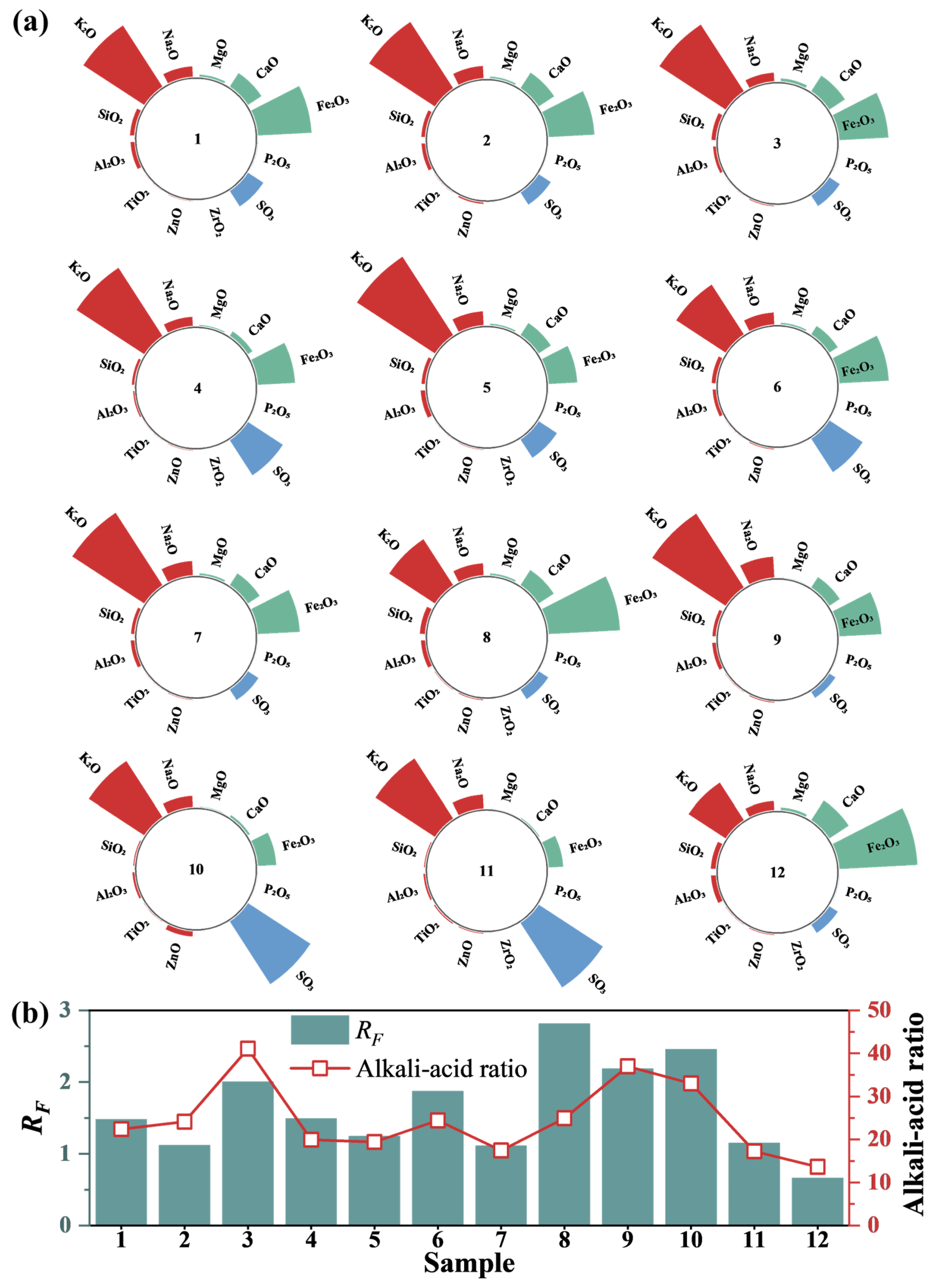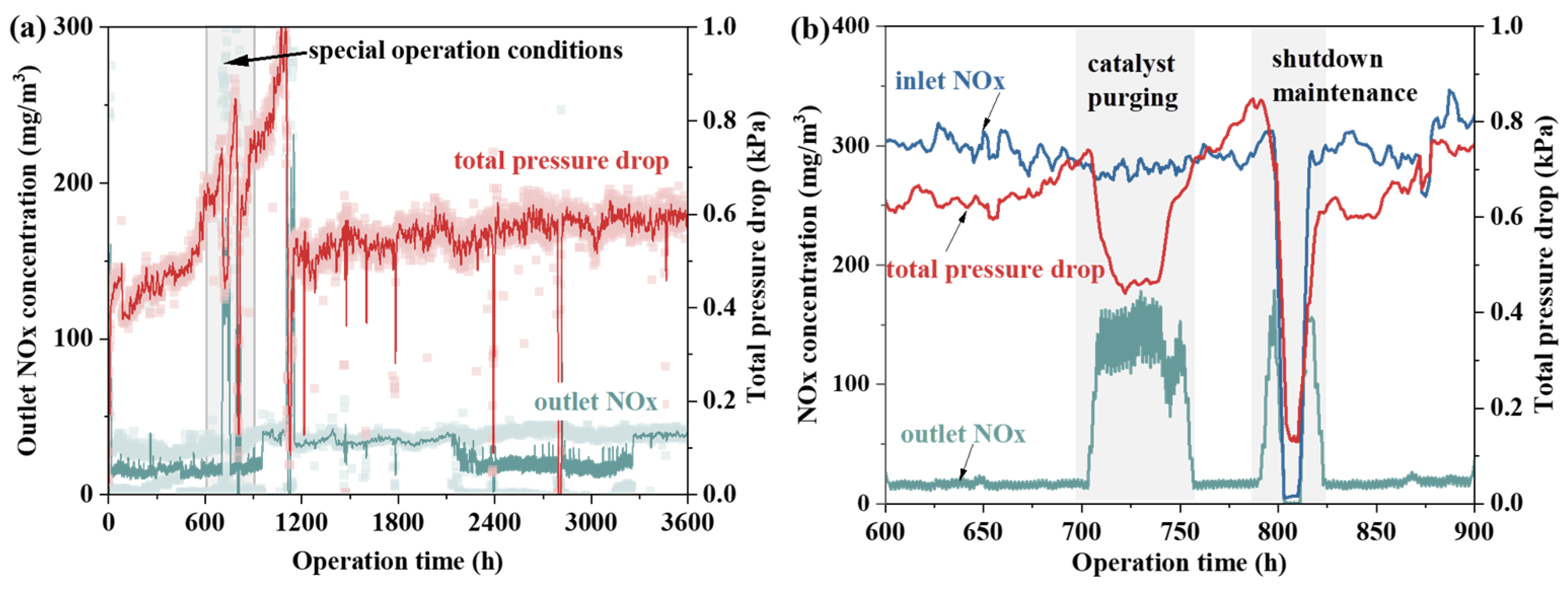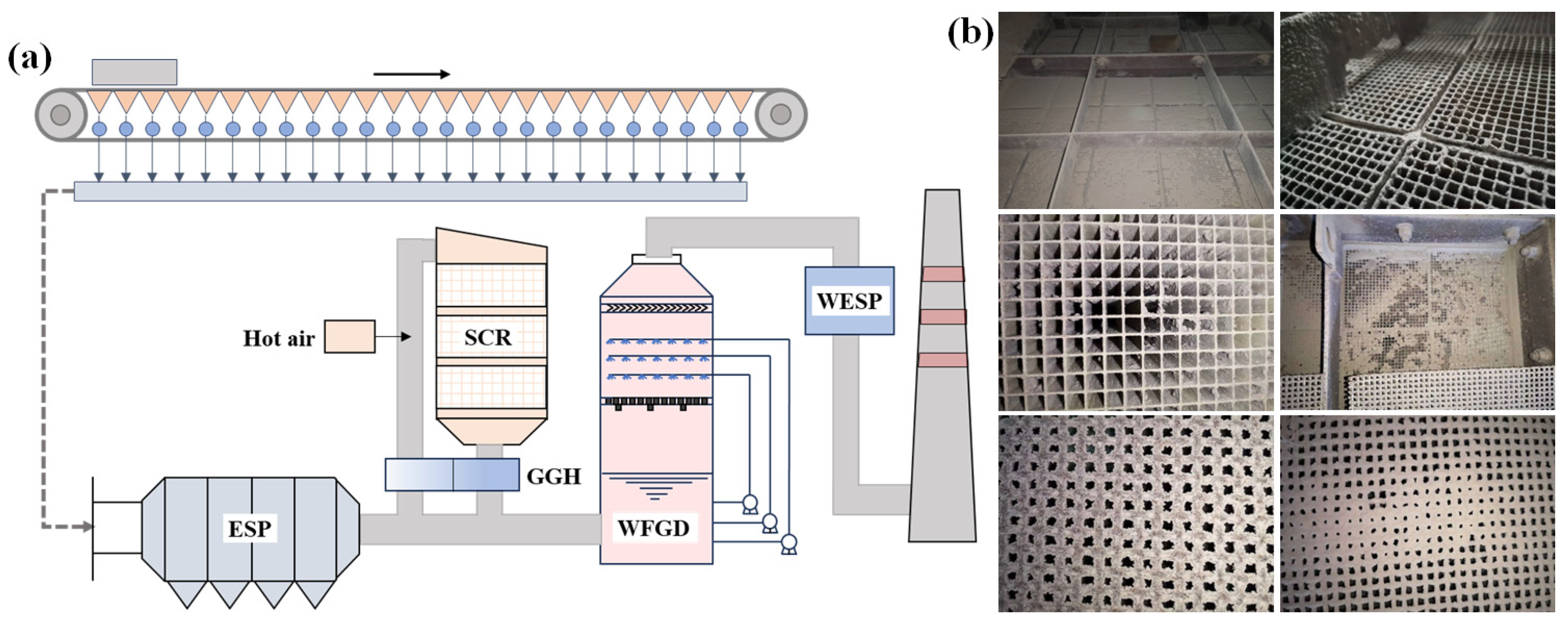Particle Conditioning for Improving Blockage Resistance of Denitration Catalysts in Sintering Flue Gas
Abstract
1. Introduction
2. Results and Discussion
2.1. Particle Morphology and Size
2.2. Composition and Contamination Characteristics
2.3. Laboratory Heating Experiments
2.4. Particle Conditioning in Application
3. Experimental Methods
3.1. Characterization of Ash Properties
3.2. Field Test
4. Conclusions
- (1)
- The composition and morphology of sintered fly ash are intrinsic factors contributing to catalyst blockage. Sintered fly ash is primarily composed of K2O, Fe2O3, Na2O, and CaO, with alkali metal oxides, particularly potassium and sodium, accounting for 20% to 50%. The distinct morphological attributes of the fly ash and the catalyst surface increase the tendency for fly ash adhesion on the catalyst.
- (2)
- Heating conditions are an extrinsic factor contributing to catalyst blockage. Under ambient conditions, sintered fly ash does not agglomerate, but significant agglomeration occurs as the temperature increases. Particle conditioning effectively reduces this tendency for agglomeration.
- (3)
- Field tests show that catalyst activity remains unaffected even under severe blockage conditions. The pressure drop across the catalyst layers increases progressively, with the first layer showing the lowest drop and the third the highest. After particle conditioning, the pressure drop remains consistently below 600 Pa.
Author Contributions
Funding
Data Availability Statement
Conflicts of Interest
References
- Tang, L.; Xue, X.; Jia, M.; Jing, H.; Wang, T.; Zhen, R.; Huang, M.; Tian, J.; Guo, J.; Li, L. Iron and steel industry emissions and contribution to the air quality in China. Atmos. Environ. 2020, 237, 117668. [Google Scholar] [CrossRef]
- Zhang, X.H.; Feng, P.; Xu, J.R.; Feng, L.B.; Qing, S. Numerical research on combining flue gas recirculation sintering and fuel layered distribution sintering in the iron ore sintering process. Energy 2020, 192, 116660. [Google Scholar] [CrossRef]
- Zhu, T.; Wang, X.; Yu, Y.; Li, C.; Yao, Q.; Li, Y. Multi-process and multi-pollutant control technology for ultra-low emissions in the iron and steel industry. J. Environ. Sci. 2023, 123, 83–95. [Google Scholar] [CrossRef]
- Cui, L.; Liu, M.; Yuan, X.; Wang, Q.; Ma, Q.; Wang, P.; Hong, J.; Liu, H. Environmental and economic impact assessment of three sintering flue gas treatment technologies in the iron and steel industry. J. Clean. Prod. 2021, 311, 127703. [Google Scholar] [CrossRef]
- Chen, H.; Luo, M.; Wang, Y.; Zhang, Q.; Liu, Y. Influence of Coal-Fired Boiler Fly Ash on SCR Denitration Catalysts and Preventive Measures. J. Combust. Sci. Technol. 2017, 23, 200–211. [Google Scholar]
- Xu, Y.; Zhang, Y.; Liu, F.; Shi, W.; Yuan, J. CFD analysis on the catalyst layer breakage failure of an SCR-DeNOx system for a 350 MW coal-fired power plant. Comput. Chem. Eng. 2014, 69, 119–127. [Google Scholar] [CrossRef]
- Feng, H.; Wang, C.; Huang, Y. Particle deposition behaviors of monolithic De-NOx catalysts for selective catalytic reduction (SCR). Korean J. Chem. Eng. 2017, 34, 2832–2839. [Google Scholar] [CrossRef]
- Heiredal, M.L.; Jensen, A.D.; Thøgersen, J.R.; Frandsen, F.J.; Friemann, J.-U. Pilot-scale investigation and CFD modeling of particle deposition in low-dust monolithic SCR DeNOx catalysts. AIChE J. 2013, 59, 1919–1933. [Google Scholar] [CrossRef]
- Yang, J.; Ma, H.; Yamamoto, Y.; Yu, J.; Xu, G.; Zhang, Z.; Suzuki, Y. SCR catalyst coated on low-cost monolith support for flue gas denitration of industrial furnaces. Chem. Eng. J. 2013, 230, 513–521. [Google Scholar] [CrossRef]
- Yu, C.; Si, F.; Ren, S.; Jiang, X. Experimental and numerical predictions of ash particle erosion in SCR monolithic catalysts for coal-fired utility boilers. Korean J. Chem. Eng. 2017, 34, 1563–1575. [Google Scholar] [CrossRef]
- Jiang, Y.; Lai, C.Z.; Li, Q.Y.; Gao, W.Q.; Yang, L.; Yang, Z.D.; Lin, R.Y.; Wang, X.W.; Zhu, X.B. The poisoning effect of KCl and K2O on CeO2-TiO2 catalyst for selective catalytic reduction of NO with NH3. Fuel 2020, 280, 118638. [Google Scholar] [CrossRef]
- Jiang, Y.; Shi, W.Y.; Lai, C.Z.; Gao, W.Q.; Yang, L.; Yu, X.X.; Yang, Z.D.; Lin, R.Y. The deactivation effect of Na2O and NaCl on CeO2-TiO2 catalysts for selective catalytic reduction of NO with NH3. J. Energy Inst. 2020, 93, 1332–1340. [Google Scholar] [CrossRef]
- Jiang, Y.; Yang, L.; Liang, G.T.; Liu, S.J.; Gao, W.Q.; Yang, Z.D.; Wang, X.W.; Lin, R.Y.; Zhu, X.B. The poisoning effect of PbO on CeO2 -MoO3/TiO2 catalyst for selective catalytic reduction of NO with NH3. Mol. Catal. 2020, 486, 82–91. [Google Scholar] [CrossRef]
- Zhuang, K.; Yao, J.; Wu, B.; Ma, X.; Shen, Y.; Du, M.; Zhong, P. Numerical Simulation of the Distribution Discrepancies between Flue Gas Flow Field and Fly Ash Concentration Field in SCR De-NOx Reactor. Electr. Power 2018, 51, 137–142. [Google Scholar]
- Yue, P.; Lei, Y.; Chen, S.; Liu, X.; Meng, L.; Gu, X. Experimental investigation on pressure drop characteristics and efficiency of large particle ash interceptor for SCR denitration system. Therm. Power Gener. 2022, 51, 119–125. [Google Scholar]
- Wang, F.; Li, W. Analysis and Treatment of Ash Deposition in SCR Denitration Equipments of W Boiler. Electr. Power 2019, 52, 178–184. [Google Scholar]
- Zheng, Y.; Jensen, A.D.; Johnsson, J.E.; Thøgersen, J.R. Deactivation of V2O5-WO3-TiO2 SCR catalyst at biomass fired power plants: Elucidation of mechanisms by lab-and pilot-scale experiments. Appl. Catal. B Environ. 2008, 83, 186–194. [Google Scholar] [CrossRef]
- Cheng, X.; Bi, X.T. A review of recent advances in selective catalytic NOx reduction reactor technologies. Particuology 2014, 16, 1–18. [Google Scholar] [CrossRef]
- Jin, L.; Xie, X.; Huang, F.; Lu, C.; Zhou, J.; Song, Y. Experimental Study on the Technology of Large Particle Ash Interception for SCR De-NOx Equipment. Electr. Power 2018, 51, 156. [Google Scholar]
- Qi, L.; Yuan, Y. Characteristics and the behavior in electrostatic precipitators of high-alumina coal fly ash from the Jungar power plant, Inner Mongolia, China. J. Hazard. Mater. 2011, 192, 222–225. [Google Scholar] [CrossRef]
- Mahalik, K.; Sahu, J.; Patwardhan, A.V.; Meikap, B. Kinetic studies on hydrolysis of urea in a semi-batch reactor at atmospheric pressure for safe use of ammonia in a power plant for flue gas conditioning. J. Hazard. Mater. 2010, 175, 629–637. [Google Scholar] [CrossRef] [PubMed]
- Qi, L.; Zhang, Y. Effects of water vapor on flue gas conditioning in the electric fields with corona discharge. J. Hazard. Mater. 2013, 256, 10–15. [Google Scholar]
- Zheng, C.; Shen, Z.; Yan, P.; Zhu, W.; Chang, Q.; Gao, X.; Luo, Z.; Ni, M.; Cen, K. Particle removal enhancement in a high-temperature electrostatic precipitator for glass furnace. Powder Technol. 2017, 319, 154–162. [Google Scholar] [CrossRef]
- Zheng, C.H.; Liu, X.T.; Yan, P.; Zhang, Y.X.; Wang, Y.; Qiu, K.Z.; Gao, X. Measurement and prediction of fly ash resistivity over a wide range of temperature. Fuel 2018, 216, 673–680. [Google Scholar] [CrossRef]
- Lanza, A.; Usberti, N.; Forzatti, P.; Beretta, A. Kinetic and Mass Transfer Effects of Fly Ash Deposition on the Performance of SCR Monoliths: A Study in Microslab Reactor. Ind. Eng. Chem. Res. 2021, 60, 6742–6752. [Google Scholar] [CrossRef]
- Su, G.; Zhang, X.; Zhong, Y.; Wei, Y. Evaluation method for ash fouling characteristics of coals with high alkali content. Therm Power Gener. 2016, 45, 9–13. [Google Scholar]







Disclaimer/Publisher’s Note: The statements, opinions and data contained in all publications are solely those of the individual author(s) and contributor(s) and not of MDPI and/or the editor(s). MDPI and/or the editor(s) disclaim responsibility for any injury to people or property resulting from any ideas, methods, instructions or products referred to in the content. |
© 2024 by the authors. Licensee MDPI, Basel, Switzerland. This article is an open access article distributed under the terms and conditions of the Creative Commons Attribution (CC BY) license (https://creativecommons.org/licenses/by/4.0/).
Share and Cite
Sun, D.; Li, P.; Zhou, C.; Chen, L.; Yang, Y.; Yang, Z.; Wang, Y.; Zheng, C. Particle Conditioning for Improving Blockage Resistance of Denitration Catalysts in Sintering Flue Gas. Catalysts 2024, 14, 698. https://doi.org/10.3390/catal14100698
Sun D, Li P, Zhou C, Chen L, Yang Y, Yang Z, Wang Y, Zheng C. Particle Conditioning for Improving Blockage Resistance of Denitration Catalysts in Sintering Flue Gas. Catalysts. 2024; 14(10):698. https://doi.org/10.3390/catal14100698
Chicago/Turabian StyleSun, Deshan, Peiyuan Li, Can Zhou, Linghong Chen, Yang Yang, Zhengda Yang, Yifan Wang, and Chenghang Zheng. 2024. "Particle Conditioning for Improving Blockage Resistance of Denitration Catalysts in Sintering Flue Gas" Catalysts 14, no. 10: 698. https://doi.org/10.3390/catal14100698
APA StyleSun, D., Li, P., Zhou, C., Chen, L., Yang, Y., Yang, Z., Wang, Y., & Zheng, C. (2024). Particle Conditioning for Improving Blockage Resistance of Denitration Catalysts in Sintering Flue Gas. Catalysts, 14(10), 698. https://doi.org/10.3390/catal14100698






